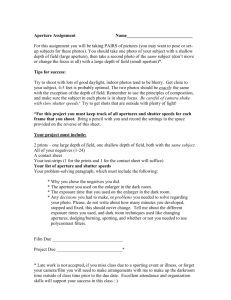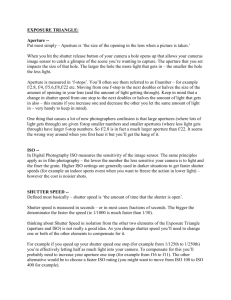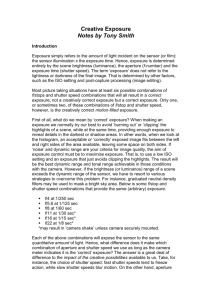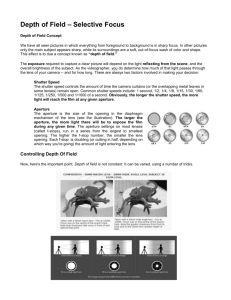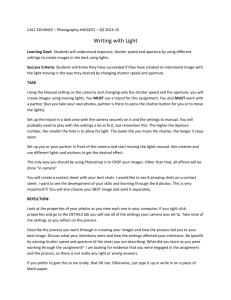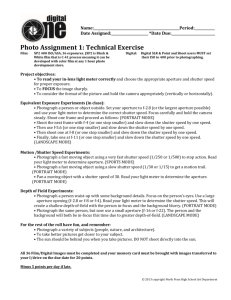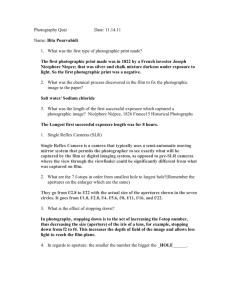Lesson Plan
advertisement
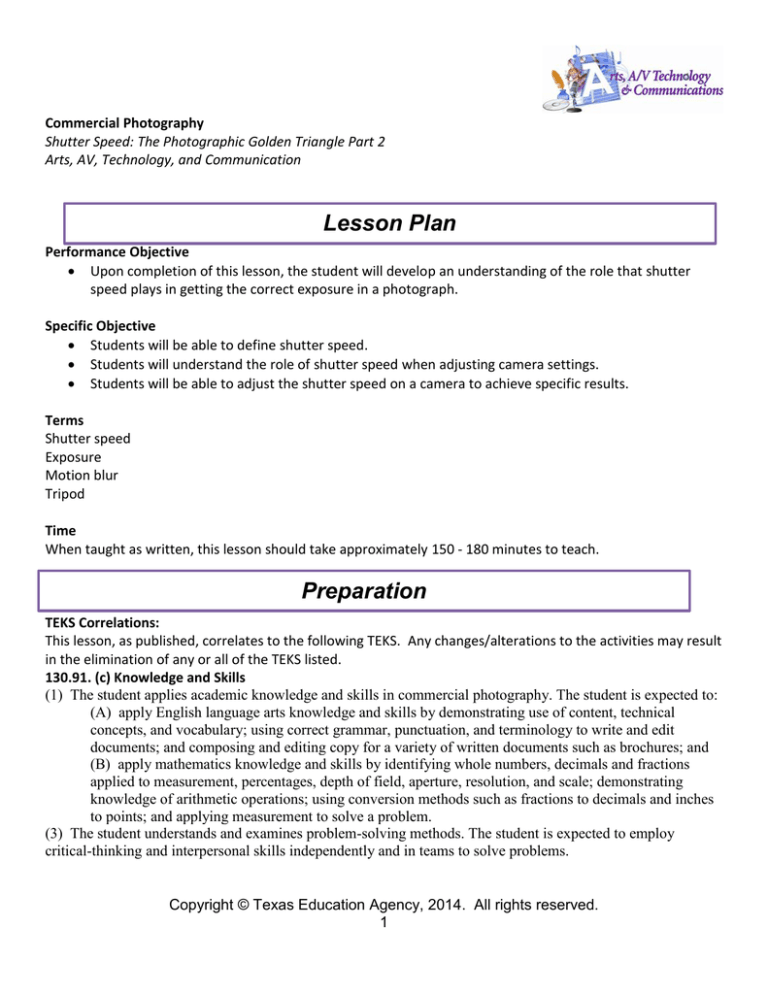
Commercial Photography Shutter Speed: The Photographic Golden Triangle Part 2 Arts, AV, Technology, and Communication Lesson Plan Performance Objective Upon completion of this lesson, the student will develop an understanding of the role that shutter speed plays in getting the correct exposure in a photograph. Specific Objective Students will be able to define shutter speed. Students will understand the role of shutter speed when adjusting camera settings. Students will be able to adjust the shutter speed on a camera to achieve specific results. Terms Shutter speed Exposure Motion blur Tripod Time When taught as written, this lesson should take approximately 150 - 180 minutes to teach. Preparation TEKS Correlations: This lesson, as published, correlates to the following TEKS. Any changes/alterations to the activities may result in the elimination of any or all of the TEKS listed. 130.91. (c) Knowledge and Skills (1) The student applies academic knowledge and skills in commercial photography. The student is expected to: (A) apply English language arts knowledge and skills by demonstrating use of content, technical concepts, and vocabulary; using correct grammar, punctuation, and terminology to write and edit documents; and composing and editing copy for a variety of written documents such as brochures; and (B) apply mathematics knowledge and skills by identifying whole numbers, decimals and fractions applied to measurement, percentages, depth of field, aperture, resolution, and scale; demonstrating knowledge of arithmetic operations; using conversion methods such as fractions to decimals and inches to points; and applying measurement to solve a problem. (3) The student understands and examines problem-solving methods. The student is expected to employ critical-thinking and interpersonal skills independently and in teams to solve problems. Copyright © Texas Education Agency, 2014. All rights reserved. 1 (10) The student applies technical skills for efficiency. The student is expected to employ planning and timemanagement skills to complete work tasks. (11) The student develops an increasing understanding of commercial photography. The student is expected to: (L) produce a variety of photographs using current, industry-standard production processes; and (M) evaluate photographs using principles of art, commercial photography standards, and criticalthinking skills. Interdisciplinary Correlations: English-English I 110.31(b)(1). Reading/Vocabulary Development. Students understand new vocabulary and use it when reading and writing. 110.3(b)(11). Reading/Comprehension of informational text/procedural texts. Students understand how to glean and use information in procedural texts and documents. 110.53(b)(2)(B) employ precise language and technical vocabulary to communicate ideas clearly and concisely Occupational Correlation (O*Net – www.onetonline.org/): Job Title: Photographer O*Net Number: 27-4021.00 Reported Job Titles: Photographer, Advertising Photographer, Studio Photographer Tasks: Take pictures of individuals, families, and small groups, either in studio or on location. Adjust apertures, shutter speeds, and camera focus based on a combination of factors such as lighting, field depth, subject motion, film type, and film speed. Determine desired images and picture composition, selecting and adjusting subjects, equipment, and lighting to achieve desired effects. Estimate or measure light levels, distances, and numbers of exposures needed, using measuring devices and formulas. Soft Skills: Critical Thinking, Judgment and Decision Making, Reading Comprehension Accommodations for Learning Differences It is important that lessons accommodate the needs of every learner. These lessons may be modified to accommodate your students with learning differences by referring to the files found on the Special Populations page of this website. Copyright © Texas Education Agency, 2014. All rights reserved. 2 Preparation Review and familiarize yourself with the terminology, website links, and proper camera handling techniques. Download or take example photographs that exemplify frozen and blurred motion through the use of shutter speed. Have materials and websites ready to go prior to the start of the lesson. References Jacobson, R. E. (2000). The manual of photography: photographic and digital imaging. (9th ed.). Oxford: Focal Press. Instructional Aids Shutter Speed Lesson Plan: Photographic Golden Triangle Part 2 Shutter Speed Slide Presentation: Photographic Golden Triangle Part 2 Instructor Computer/Projection Unit Teacher-selected websites related to this lesson Multiple DSLR cameras outfitted with memory cards. Tripods Shutter Speed Quiz Quiz answer Key Frozen and Blurred Motion Grading Rubric Computer Diagrams/Charts as needed Industry-standard software Introduction Show students a series of different photographs that exemplify motion both frozen and blurred. Ask students how that effect was achieved. Explain to students that shutter speed is one of the three different parts of the photographic triangle. Ask students the following questions to students and discuss their answers: Why is it so hard to get a good, non-blurry shot at a football game at night? What do you think is the longest possible shutter speed? How fast do you think cameras can take photos? Copyright © Texas Education Agency, 2014. All rights reserved. 3 What do you think is the fastest possible shutter speed? Outline MI Outline Introduce lesson to students by doing the following: Instructor Notes Note: Many students will have their own cameras and the Show students a variety of different photographs that exemplify motion both blurred and frozen. methods for adjusting the shutter speed on their cameras may be Ask questions about the photos and how the effects were achieved. Explain to students that shutter speed is one of the three different parts of the photographic triangle and is used to determine how “fast” any given exposure is. different. Make sure that if a Then, go through the slide presentation with students. Discuss the following: I: General Overview a. What is shutter speed? b. Measuring shutter speed II: Shutter Speed and Light a. Longer shutter speeds lets light in for a longer amount of time b. Faster shutter speeds let light in for a short amount of time III: Shutter Speed and Motion a. Longer shutter speeds will blur motion b. Faster shutter speeds will freeze motion IV: Aperture and the Human Eye a. Correlations between aperture and the human eyeball V: Review their shutter speed. student has a camera different than the one shown in class, they also know how to adjust Remind students that when shooting images with longer exposures (anything slower than 1/60th”) they will need to utilize a tripod. Copyright © Texas Education Agency, 2014. All rights reserved. 4 Multiple Intelligences Guide Existenti alist Interpers onal Intrapers onal Kinesthe tic/ Bodily Logical/ Mathema tical Musical/Rhyt hmic Natura list Verbal/Ling uistic Visual/Sp atial Application Guided Practice The teacher will show the PowerPoint and explain the general way to adjust the shutter speed and the reason for shutter speed adjustments. Teacher will model for students the proper camera handling techniques. The instructor will demonstrate how to change the shutter speed on the DSLR in both shutter speed priority (“TV”) and manual (“M”) modes. Give small groups of students a DSLR to work with and have students adjust the shutter speed on the cameras in various modes. Encourage students to pay attention to the resulting changes in light and motion in their photos after adjusting their aperture. The teacher will observe students while working and reteach if needed. Independent Practice After going over the slide presentation, do the following: Divide students into groups of three or four. Give each group a camera with a memory card (if students have their own memory cards, this is even better). Instruct students to take two photographs: o One photograph should exhibit a motion that has been frozen using a fast shutter speed. o One photograph should exhibit the same motion that has been blurred using a slower shutter speed. For this one, students will most likely have to utilize a tripod. Instruct students to set their DSLR to either manual mode (“M”) or shutter speed priority mode (“TV”). Students should be given approximately 30 minutes to complete the task. After the task is completed, students should upload their photos to a shared folder where the instructor can view all of the photographs. Ask students to explain how they went about completing the assignment. During the discussion ask students if each team member was used effectively take a photo with a shallow depth of field. Copyright © Texas Education Agency, 2014. All rights reserved. 5 Summary Conduct a question and answer session with students about shutter speed-related questions. Review talking points and key terms from slide presentation. Ask students what they would adjust on their cameras if they needed to freeze motion. Ask students how they would adjust their shutter speed if they wanted less light in a given exposure. Ask students how they would adjust their shutter speed if they wanted more light in a given exposure. Ask students how they would adjust their shutter speed if they wanted to freeze motion Have students assess and critique their own work and other students’ work. Evaluation Informal Assessment Any or all of the following may be used as informal assessments : Instructor Observation Question and answer Instructor will discuss and reteach where needed. Formal Assessment Frozen and blurred motion photographs will be assessed using the rubric (attached). Students may also be assessed through the shutter speed quiz and quiz answer key. Enrichment Extension Students are also encouraged to take their own light painting or stair trail images using long exposures and tripods. Copyright © Texas Education Agency, 2014. All rights reserved. 6 Frozen and Blurred Motion Grading Rubric Criteria Completeness (10 pts) Basic (30 points) Understanding (20 pts) Creativity (30 points) Design (10 pts) Comments: Exceptional Above Average Below Average Unacceptable 9-10 points 5-8 points 1-4 points 0 points Work is complete and presents a unified whole. Work is complete, but lacks unity or Gestalt. Work is incomplete. No attempt was made to produce the document. 27-30 points 15-26 points 1-14 points 0 points Photographs have a focal point and it is in focus. Principles of design are in use in the photograph. Photographs have a focal point and are in focus. Slight issues with focus or subject. Subject lacks a focal point. Focus issues. 17-20 points The student used shutter speed to freeze and blur motion in a unique way. Design principles are also at use. 27-30 points 9 -16 points 1-8 points 0 points Student has achieved a both blurred motion and frozen motion through shutter speed. Either blurred or frozen motion is missing. Photo does not exhibit frozen or blurred motion through shutter speed. 15-26 points 1-14 points 0 points Ideas are original in thought and exceptionally creative. Ideas are somewhat original and creative. Limited evidence of creativity and originality in thought. No evidence of creativity or originality in thought or execution of project. 9-10 points 5-8 points 1-4 points 0 points Photos have been arranged as a diptych. Principles of design are evident in the design. Assignment has been turned in as a diptych. Fair project. Few errors present. Photos were incorrectly placed in design or not turned in digitally. TOTAL POINTS: Copyright © Texas Education Agency, 2014. All rights reserved. 7 Points 1. 2. 3. 4. 5. 6. 7. Shutter Speed Quiz Which of the following shutter speeds would be more likely to FREEZE motion? a. 1/800 b. f/2.8 c. 4” d. f/22 Which of the following shutter speeds would be more likely to BLUR motion? a. 1/800 b. f/2.8 c. 4” d. f/22 Which of the following shutter speeds would let in the MOST amount of light? a. 1/60 b. 1/6 c. f/5.6 d. 6” Which of the following shutter speeds would let in the LEAST amount of light? a. 1/60 b. 1/6 c. f/5.6 d. 6” Which of the is the slowest possible shutter speed that you should still hand hold your camera? a. 1/600 b. 1/60 c. 1/6 d. 60” Which of the following “auto-exposure” modes allows the user to control the shutter speed with the camera automatically selecting the aperture and ISO values? a. M b. A or AV c. TV d. Portrait If you adjust your shutter speed from 1/40 to 1/200, what should you do to your aperture in order to get a similar exposure? Write out in words how long the following shutter speeds would be: 8. 8”6 9. 60” Copyright © Texas Education Agency, 2014. All rights reserved. 8 10. 1/400 Shutter Speed Quiz Key 1. Which of the following shutter speeds would be more likely to FREEZE motion? a. 1/800 b. f/2.8 c. 4” d. f/22 2. Which of the following shutter speeds would be more likely to BLUR motion? a. 1/800 b. f/2.8 c. 4” d. f/22 3. Which of the following shutter speeds would let in the MOST amount of light? a. 1/60 b. 1/6 c. f/5.6 d. 6” 4. Which of the following shutter speeds would let in the LEAST amount of light? a. 1/60 b. 1/6 c. f/5.6 d. 6” 5. Which of the is the slowest possible shutter speed that you should still hand hold your camera? a. 1/600 b. 1/60 c. 1/6 d. 60” 6. Which of the following “auto-exposure” modes allows the user to control the shutter speed with the camera automatically selecting the aperture and ISO values? a. M b. A or AV c. TV d. Portrait 7. If you adjust your shutter speed from 1/40 to 1/200, what should you do to your aperture in order to get a similar exposure? You would need to open up your aperture wider (go down to a smaller f-stop number) Write out in words how long the following shutter speeds would be: 8. 8”6 – eight seconds and six tenths of a second Copyright © Texas Education Agency, 2014. All rights reserved. 9 9. 60” – sixty seconds 10. 1/400 - one four hundredth of a second. Copyright © Texas Education Agency, 2014. All rights reserved. 10
